This Crusty Spelt Bread, baked in a loaf pan, utilizes an overnight sponge to help develop the gluten structure and enhance the flavor. I’ve used this method a few times; each time with a different type of flour. For this experiment, I used a mixture of white and whole grain Spelt.
Using an overnight sponge helps with gluten development. This is particularly useful when working with ancient grains because they generally have a weaker gluten structure. Allowing the final dough to ferment for a longer period of time also aids with gluten development.
Due to the weaker protein structure, doughs made with spelt also benefit from a shorter mix. It’s generally better to mix them by hand or utilize a shorter mix on first speed in a stand mixer. Due to these characteristics, I felt this would be a good dough to test in the EZ DOH unit.
This bread can be baked in a regular loaf pan or as a freeform artisan loaf. I tried it both ways (see photo below). The loaf on the left is made with white and whole grain Spelt. The loaf on the right is made completely with whole grain Spelt and baked on a baking stone using steam.
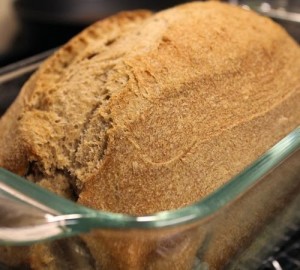 |
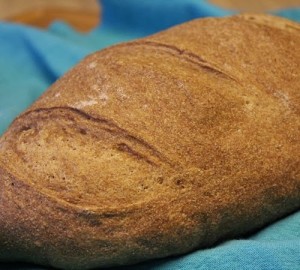 |
This post documents the process for making Spelt bread in a loaf pan. If you want to learn how to bake the hearth-style loaf, refer to the Einkorn Bread made with an Overnight Sponge post. Just substitute Spelt for the Einkorn flour.
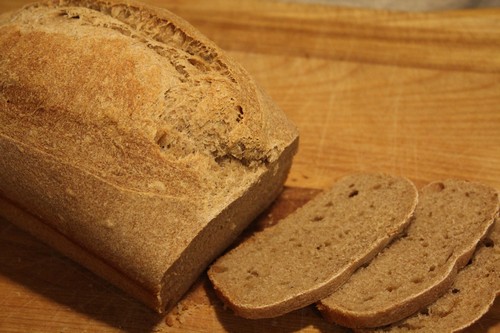
Crusty Spelt Bread
The dough for this bread was mixed in an EZ DOH manual bread dough mixer, but it could just as easily be mixed in a stand mixer or by hand using a Danish Dough Whisk. Just keep in mind that spelt benefits from a shorter mixing time.
Makes: 1 Loaf
Adapted from: Bread Science by Emily Buehler
Ingredients:
Sponge:
- 187 g (1 2/3 cups) white Spelt flour
- 140 g (2/3 cup) water (50 to 55 degrees F.)
- 1/8 tsp. instant yeast
Final Dough:
- 210g (~1 3/4 cups) whole grain Spelt flour (plus more for sprinkling)
- 327g Sponge (all of it)
- 140g (2/3 cup) water (60 to 65 degrees F.)
- 1/2 tsp. instant yeast
- 2 tsp. salt
Mixing the Sponge:
Mix the sponge 12 to 15 hours before you plan to make the dough. If the temperature is cooler in the house, then use warmer water, if it is warmer in the house, then use cooler water. Final temperature should be about 65 degrees F.
I mixed the sponge in the EZ DOH unit and let it rest in the unit overnight.
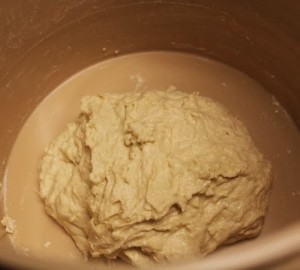 |
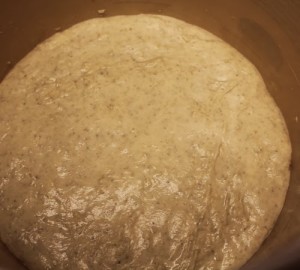 |
After the overnight rest, I added about half the water to break up the sponge. I mixed the sponge and the water for a minute or so, then I added the dry ingredients and starting mixing while I gradually added the rest of the water. I mixed until all of the dry ingredients were incorporated into the dough. Then I removed the handle assembly and kneaded the dough just a bit (in the bucket) with my hands.
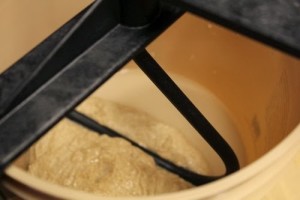 |
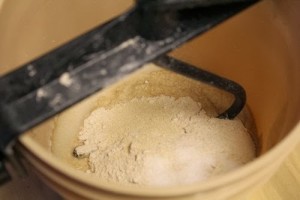 |
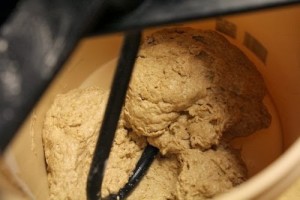 |
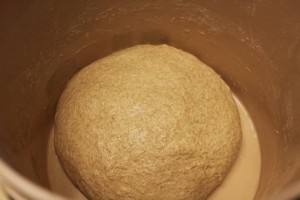 |
Cover with plastic wrap or a kitchen towel and let the dough bulk ferment for 2 hours total. After 1 hour, fold and turn the dough in the bowl or take it out and perform a fold on the counter or work surface.
Place the dough back in the bucket, cover again, and let it bulk ferment for another hour.
After the 2nd hour, shape the dough into a loaf. Place the loaf seam side down in an 8 1/2” x 4 1/2” loaf pan. I used a glass loaf pan.
I scored the loaf before the final proof so it wouldn’t deflate the dough. This is recommended for weaker doughs. It also gives the scores more definition after baking.
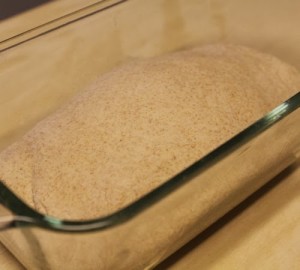 |
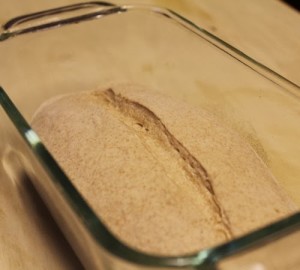 |
Let the loaf proof for an hour. It probably won’t double in size during the proof, but the oven spring should be very good.
Preheat the oven to 375 degrees F. Bake for 25 to 30 minutes or until a wooden skewer inserted in the middle comes out clean. The crust should be brown and crusty.
Remove the loaf to a wire rack to cool completely before slicing and serving.
I liked using the EZ DOH bread maker although it did require a bit of hands on kneading. If you’re making breads by hand, this shouldn’t be an issue because you want to get your hands on the dough to make sure it’s developing properly. It seems to be a useful tool for mixing no knead breads and breads that require a longer fermentation to develop the gluten.
Happy Baking!
Cathy
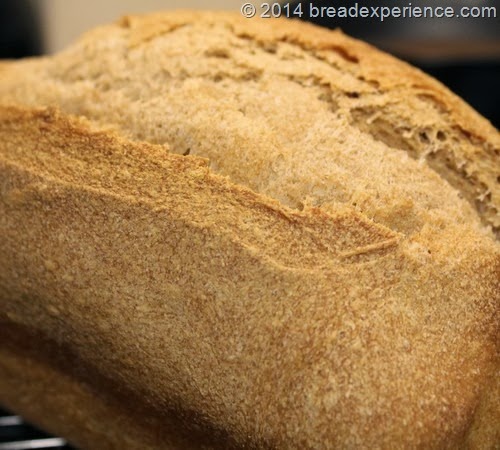
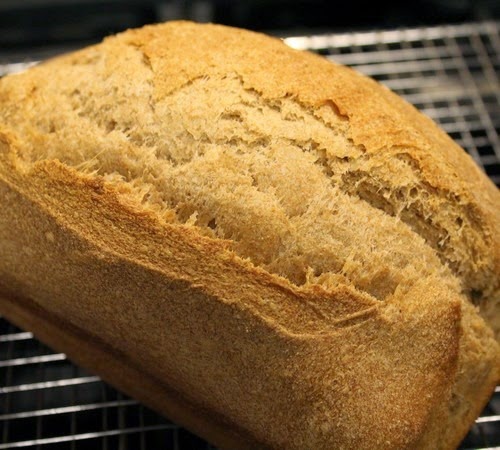
John Miller says
I tried this bread and liked it. It has a nice chewy texture which I have not had with the spelt sandwich bread recipes I have used.
Cathy says
Hello John,
Thank you for sharing your experience with this spelt bread. I’m so glad you liked it. I enjoy this method as well.
Happy Baking!
Cathy
Kathy says
Hi! Thanks for the recipe. The bread is on its second rise right now- can’t wait to taste it!
I found the instructions confusing, though, regarding the rising times – I think both rising times are one hour, but then you refer to “the 2 hour” rise (or fermentation). Is one of the rising times supposed to be 2 hours long? If you could clarify the instructions on those points, it would be helpful.
Thanks again.
Cathy says
Hi Kathy, the total bulk fermentation is 2 hours. You do a fold after the 1st hour, then let it ferment an additional hour, then shape it into a loaf. I edited the instructions to hopefully make things more clear. Thanks!
Sue Linn says
can sprouted whole grain spelt flour be used for this recipe?
Cathy says
Hi Sue, yes sprouted spelt flour can be used. You may need to adjust the hydration since sprouted flour typically absorbs more water. Happy Baking!
Sue Linn says
I made the recipe but found it quite salty…..will try it again with 1/2 the salt.
Cathy says
Thanks! Do let me know how it goes.
christine says
Sorry to ak but what is EZ DOH
Cathy says
EZ Doh is a manual bread dough mixer. https://www.breadexperience.com/product/ez-doh-bread-maker/
Kristen says
Do you think a 5qt stand mixer bowl could contain the dough while it’s rising?
Cathy says
Yes, the dough just needs to be able to climb up the bowl while its rising.
Anna says
The best bread I have ever had!!! Perfect recipe,
Thank you, thank you, thank you!!!
Cathy says
Hi Anna, Thanks for sharing your feedback. I’m so glad you liked it.
Tina says
Hi. Can I use active dry yeast instead of instant yeast? Also what does it mean to “proof” and to “score” the loaf? Thank you.
Cathy says
Hello Tina,
These are all good questions. Yes, you can use active dry yeast instead of instant, but active dry yeast should be activated in warm water before mixing in the flour. Proofing refers to the final rise before baking the bread. A lot of doughs will double in size during the proof cycle, but this particular bread doesn’t rise that much. Scoring the loaf means to slash it with a knife, or lame so that the loaf opens up during baking and doesn’t tear. You can find more helpful terms in this section of the site https://www.breadexperience.com/bread-baking-terms-p-z/
Happy Baking!
Cathy
Jarrard says
Few questions.
Is this bread soft anf fluffy at all or is it a heavier bread?
I’ve noticed it has no sugars for the yeast and also no fats to soften it up.
Cathy says
Hi Jarrad, this spelt bread is not a soft and fluffy bread. It is a crusty bread like French bread that doesn’t contain added sugar or fat.
Jerry says
No oven spring what did I do Wong
Cathy says
Did your loaf rise at all in the oven? Or did it rise nicely during the final proof but flatten out during baking?
If you made this loaf with spelt, it could be the loaf was overproofed so it didn’t rise anymore when baked. It’s very easy to overproof loaves made with spelt.
Seth says
Any chance on getting and picture of the inside? Thanks!
Cathy says
Sure. The post has been updated with the crumb shot of the loaf baked in a loaf pan.